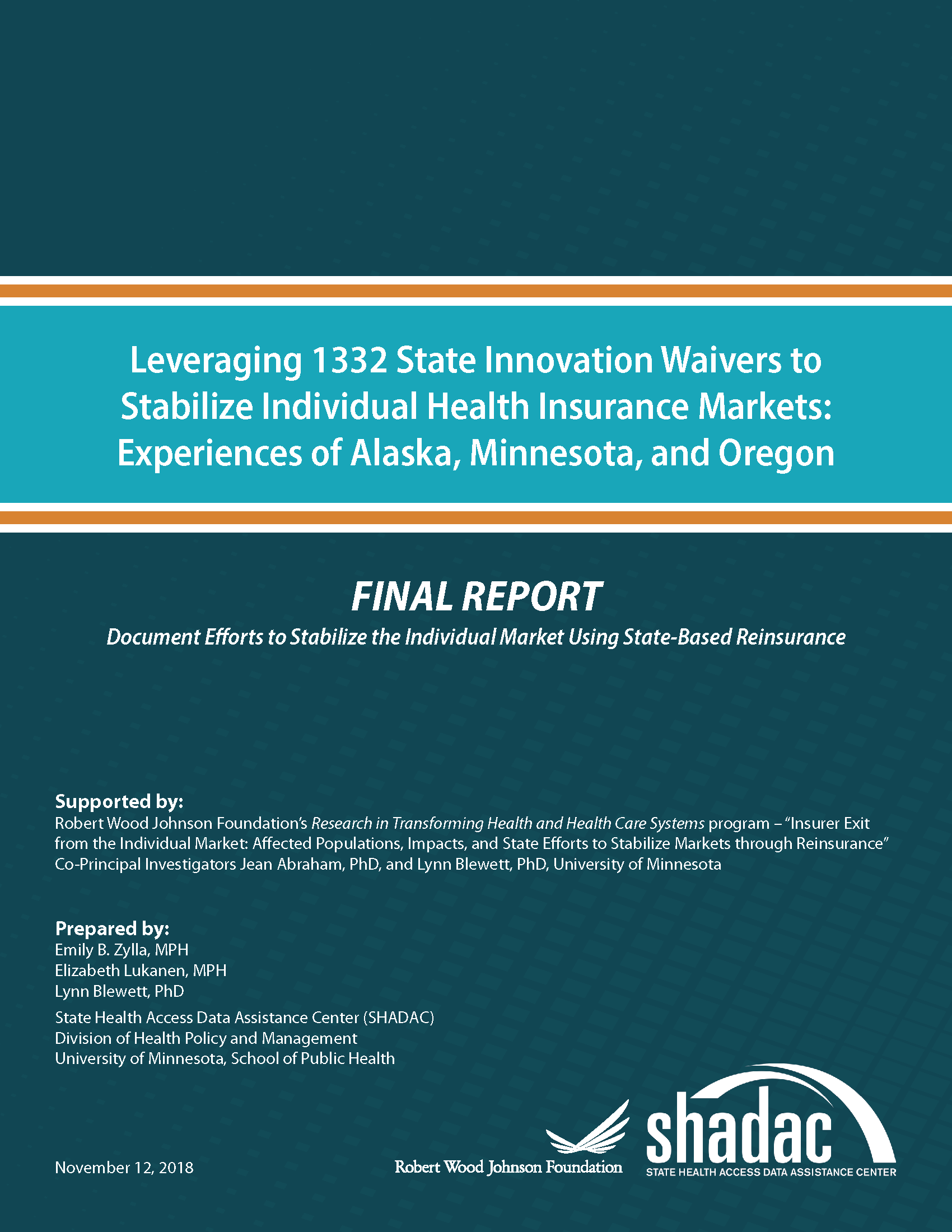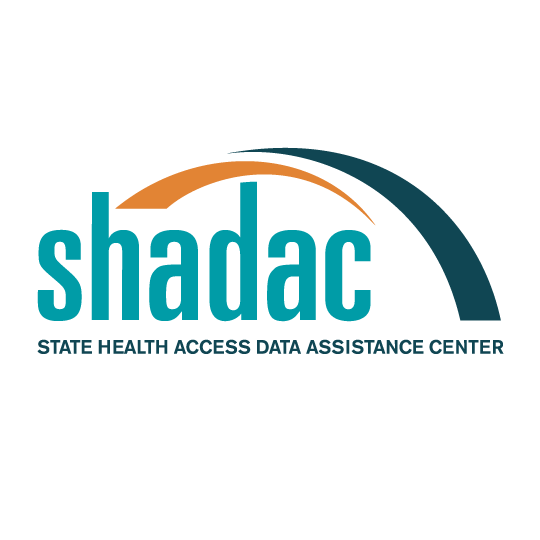Publication
Leveraging 1332 State Innovation Waivers to Stabilize Individual Health Insurance Markets: Experiences of Alaska, Minnesota, and Oregon (Final Report)
 In 2017, Alaska, Minnesota, and Oregon became the first three states to receive federal approval to establish state reinsurance programs with federal funding via section 1332 State Innovation Waivers, which authorize states to waive key requirements under the law in order to experiment with different policies in the individual and small group insurance market within certain guardrails. A new SHADAC analysis, prepared for the Robert Wood Johnson Foundation, examines the use of 1332 State Innovations Waivers to stabilize individual health insurance markets within these states. SHADAC researchers compared the use of this strategy in Alaska, Minnesota, and Oregon, assessing how the 1332 waiver process was navigated; identifying lessons learned about this process and about different reinsurance models; and pinpointing future concerns about the use of reinsurance programs.
In 2017, Alaska, Minnesota, and Oregon became the first three states to receive federal approval to establish state reinsurance programs with federal funding via section 1332 State Innovation Waivers, which authorize states to waive key requirements under the law in order to experiment with different policies in the individual and small group insurance market within certain guardrails. A new SHADAC analysis, prepared for the Robert Wood Johnson Foundation, examines the use of 1332 State Innovations Waivers to stabilize individual health insurance markets within these states. SHADAC researchers compared the use of this strategy in Alaska, Minnesota, and Oregon, assessing how the 1332 waiver process was navigated; identifying lessons learned about this process and about different reinsurance models; and pinpointing future concerns about the use of reinsurance programs.
SHADAC conducted an in-depth document review and qualitative interviews with individuals - including state agency and executive staff, legislators, actuarial analysts, health plan representatives, program administrators, and other stakeholders - across the three study states who were involved in the design and/or implementation of state reinsurance programs and the 1332 waiver application process. Each of the states faced numerous challenges in their individual health insurance markets (high costs, increasing premiums, shifting marketplace makeup and plan availability, etc.) that led them to establish state-based reinsurance programs. However, as the report details, state policymakers found unique ways to facilitate both the waiver application and implementation processes, including working hand-in-hand with insurance companies, leveraging existing infrastructure and experience within their own agencies, having mechanisms in place to get analysis done quickly, and engaging with the state’s congressional delegation.
Alaska, Minnesota, and Oregon: Reinsurance Models
In 2017, Alaska, Minnesota, and Oregon became the first three states to receive federal approval to establish state reinsurance programs with federal funding via section 1332 State Innovation Waivers, which authorize states to waive key ACA requirements in order to experiment with different policies in the individual and small group insurance market within certain guardrails.
- Alaska’s state reinsurance program is condition-based, paying 100% of claims from policyholders who have one of 33 possible specific medical conditions.
- The Minnesota Premium Security Plan (MPSP) is a traditional reinsurance model with an attachment point of $50,000 and a cap of $250,000 with payment of claims at an 80/20 coinsurance rate.
- The Oregon Reinsurance Program is a traditional reinsurance model with a 50/50 coinsurance rate, as well as an attachment point and cap to be determined at a later date.
Challenges and Facilitators of the 1332 Waiver Application Process
Interviewees across all stated noted numerous challenges during the 1332 waiver application process, including:
- Securing a state funding source
- Navigating rapid shifts in the political climate that affected the application process
- Being able to access timely data to support their applications
- Identifying a waivable requirement of the ACA
Respondents agreed, however, on common facilitators that aided the application process, which they listed as:
- Working hand-in-hand with insurance companies to keep them in the market
- Leveraging existing infrastructure and experience to support the state-based programs
- Using previously existing mechanisms to get analysis done quickly
- Engaging with the state’s congressional delegation
Lessons Learned about 1332 Waiver Application and Implementation Processes
Interview respondents also identified a number of lessons learned by the states as they navigated both the application and implementation stages for their 1332 waivers. A few key points are listed below.
- There are both pros and cons to condition-based vs. traditional reinsurance models.
States noted that they chose reinsurance models that would be easy to implement in a short timeframe. Traditional models were less complex, but condition-based models maximized cost of care options. - Robust communication efforts with multiple stakeholders were needed.
Respondents consistently emphasized the need for dedicated communication between state agencies, legislators, health insurers, congressional delegations, CMS officials, and community stakeholders in order to put together a successful waiver application. - Microsimulation models allowed states to be responsive to rapidly shifting policies.
States were required to submit actuarial and economic analyses as part of their waiver applications, and the microsimulation models used by Alaska and Oregon allowed them to respond to several real-time policy changes (such as the repeal of the individual mandate).
Future Concerns
Though respondents in all three states felt that state-based reinsurance was necessary to help stabilize the markets, they did report a number of concerns for the future of these programs.
- It is difficult to measure the impact of reinsurance programs beyond premium rates.
All three states reported a reduction in premium costs in the individual market as a result of implementing a reinsurance program, but other evaluations of program impacts have not been clear, often due to lack of data. - No accountability measures were included.
Due to the short turnaround time to both apply for and implement their 1332 waivers, none of the study states included accountability measures within their reinsurance programs for the individual market. - Reinsurance is only a short-term fix and does not address the underlying problem of health care costs.
Although interviewees from Alaska, Minnesota, and Oregon felt that state-based reinsurance was an important tool to stabilize the individual market, all questioned the viability of such programs as a long-term solution, commenting that individual marketplaces were only part of the whole, and only when the larger picture is addressed can the root of the issue of high health care cost be properly addressed.
Related Readings and Resources
Modeling State-based Reinsurance: One option for Stabilization of the Individual Market
Minnesota’s 13332 Reinsurance Waiver Dilemma
Resource: 1332 State Innovation Waivers for State-Based Reinsurance









